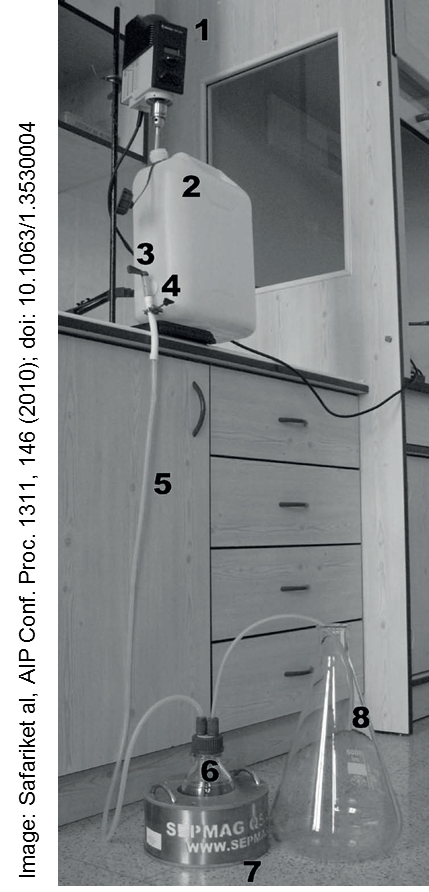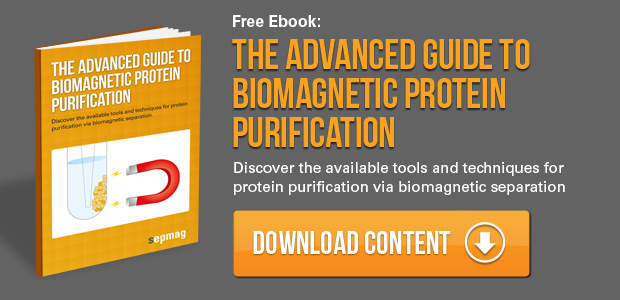The search for alternatives to chromatographic resins is not new. With the continuous increase in expression levels in recombinant protein purification, columns are struggling with crude lysates. The need to clarify suspensions containing high levels of expressed protein for post-purification re-concentration no longer appears to be the most efficient strategy. You will find much more information about this topic in our protein purification handbook.

Many process development teams have turned their attention to magnetic beads and particles. The use of immunocapture supports which can be made mobile or immobile at will showed great promise. There were two problems with initial attempts: the cost/performance of the magnetic beads and the efficiency of the biomagnetic separation process. Often, however, both problems overlapped and were difficult to distinguish.
Attempts to use the same beads as in IVD-kits were unsuccessful. Even when the immunocapture of the protein can take advantage of the technologies for coating the biomarkers, the diagnostic applications must never elute the protein. Moreover, the IVD beads need to be highly consistent (narrow size dispersion, magnetic content, binding capacity): kit-to-kit consistency must be extremely high, every fraction of the milliliter aliquot must be equal to the rest of the batch. This entails the use of a highly complex manufacturing process (and price by mg) that limits their use to screening and other small volume/high value applications.
But for downstream processes batch-to-batch consistency will suffice (typically measured in liters) and cost is almost always the key issue. Classical IVD-magnetic beads were not a right solution. However, in recent years, breakthroughs in new materials development have put alternative high-performance/cost-effective magnetic beads on the market.
Nevertheless, selecting the right beads is only half the answer. As IVD-kit producers discovered a decade ago, magnetic bead separation at milliliter scale is easily done even with a simple magnet, however, but when the process is scaled up, matters become more complicated. The main problem is that magnetic force decreases quickly with distance: when volume grows over tens of milliliters, the beads farthest from the magnet experience very low force. This means, in the best case scenario, very long separation times. In most of cases, the result is high losses.
Classical magnetic racks try to solve the problem by increasing the magnet volume but, if this succeeds, the force in the retention area increases much more quickly. As a result, irreversible bead aggregation becomes an issue and the necessary perfect re-suspension for efficient elution is a major drawback.
The solution is quite simple: generate a homogenous force throughout the entire working volume. Advanced Biomagnetic Separation Systems such as those manufactured by SEPMAG® (www.sepmag.eu) achieve this by generating specific magnetic field profiles. Fast separation/full recovery make it possible to perform stability and re-usability studies without worrying about whether the activity loss is real or merely because not all the magnetic beads are recovered. The use of homogenous biomagnetic separation systems makes it possible to focus on developing the right capture/elution molecule for the specific protein. The results can easily be transferred to larger volume homogenous force biomagnetic separation systems, making scale-up straightforward.
Some experts have also used this technology to improve other aspects of the downstream process, such as attaining higher concentrations of purified protein in the final suspension volume. Safarik and co-workers (disclosure: the author is a co-signer of the article) use the crude extract volume for capturing the protein, and then a 10th time smaller volume for immobilizing the magnetic beads/particles.
By passing the suspension through a smaller vessel after the incubation time, they achieve a factor 10 concentration with respect to the crude lysate in a single simple step without losses. Elution than can then be performed and, when the magnetic beads are immobilized again (now without the protein attached), the supernatant would have the captured protein in a tenfold concentration
Flow-through magnetic separation system.1 – mechanical overhead stirrer; 2 – container; 3 – valve; 4 – screw clamp; 5 – tubing; 6 – bottle; 7 – SEPMAG® Q500ml magnetic separator; 8 – bottle for collection of magnetic particles depleted solution/suspension).
Last but not least, biomagnetic separation performance increases with magnetic bead concentration (separation time decreases as the fourth root of the concentration of the beads according to Faraudo & Camacho). Then, in contrast to what happens with columns, increasing the protein expression level in the upstream process does not hinder downstream performance. Quite the opposite! Adding magnetic beads in excess of the binding requirements also accelerates the biomagnetic separation process.
The Advanced Biomagnetic Separation Systems currently used for manufacturing magnetic beads-IVD kits (at volumes up to tens of liters!) are the second leg of the technological revolution that can finally make immunomagnetic purification a major player in downstream processes.
You will find this post and many more interesting articles about using biomagnetic separation for protein purification in our Advanced Guide to Biomagnetic Protein Purification:
References
(1) I. Safarik et al, AIP Conf. Proc. 1311, 146 (2010).
(2) J. Faraudo & J. Camacho (2010). Colloid Polym. Sci., 288:207.
Related articles:
- Novel Hyper-porous Polymer Magnetic Beads as High-capacity/Fast separation alternative
- Effect of Particle Size Distribution of Magnetic Particles in Protein Purification Processes
- Multi-functional Nanoparticles for Protein Purification
Author: Lluís M. Martínez, Chief Scientific Officer at SEPMAG®
 Founder of SEPMAG®, Lluís holds a PhD in Magnetic Materials by the UAB. He has conducted research at German and Spanish academic institutions. Having worked in companies in Ireland, USA and Spain, he has more than 20 years of experience applying magnetic materials and sensors to industrial products and processes. He has filled several international patents on the field and co-authored more than 20 scientific papers, most of them on the subject of magnetic particle movement.
Founder of SEPMAG®, Lluís holds a PhD in Magnetic Materials by the UAB. He has conducted research at German and Spanish academic institutions. Having worked in companies in Ireland, USA and Spain, he has more than 20 years of experience applying magnetic materials and sensors to industrial products and processes. He has filled several international patents on the field and co-authored more than 20 scientific papers, most of them on the subject of magnetic particle movement.





